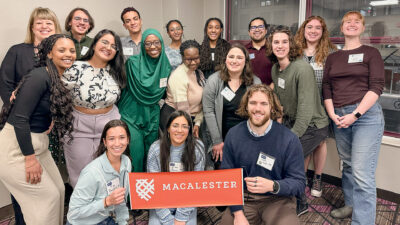
In the final battle of Avengers: Infinity War, Don Cheadle’s Colonel James Rhodes (also known as War Machine) tries to destroy Josh Brolin’s evil Thanos. Clad in his sleek armored suit with golden eyes gleaming, War Machine hovers above Thanos, firing missiles at the hulking supervillain on the ground, smoke trails snaking around him as he descends. But Thanos is still too powerful. He grabs War Machine, tosses him aside with a clank, brutally secures the final Infinity Stone that he’s been seeking, and turns almost everyone good to dust—at least for now.
This scene’s floating War Machine and flaming missiles are the work of Wei-Chuan Hsu ’07. After freelancing around Los Angeles, she landed a job as an animator on the 2018 Marvel Studios movie at Industrial Light & Magic, the Lucasfilm animation studio that provided the film’s visual effects.
As part of the previs (pre-visualization) team at The Third Floor visualization studio, Hsu brainstormed ideas for the movie’s design phase. Early on, she got to animate one of the first motion studies of Hulk battling Thanos, so the directors could get a sense of the scene’s visual possibilities. Hsu says that to get a creature’s movement just right, animators use references—snippets of motion gleaned from YouTube or real life that they can refer to while working. “We took a ton of references from other Marvel movies, regular Hollywood movies, Japanese anime, video games, kung fu movies, and all styles of martial arts movies,” she says.
The previs team creates a lot of content. Then the directors go in and make an edit of it. “We also made libraries of motion that would be used again and again, like walk cycles, run cycles, jump cycles, so that if the director wanted the creature to run from point A to point B, we could just drop it in—that’s the previs process,” Hsu says. Later, with real-life actors, animators use motion capture or “mocap,” in which people act on a stage and their movements are captured as computer-graphics characters in the computer.
Although Hsu says the eventual battle between Hulk and Thanos was mostly different from what she created, she got to animate Hulkbuster (the armored Iron Man suit used by Hulk to fight Thanos), the Outriders (Thanos’s horde of humanoids), and War Machine for the film. You will see her name twice in the movie’s credits, as a visualization and digital artist.
Hsu, who was born in Taiwan, moved to Malaysia when she was eight and lived there through high school. She chose Macalester for two reasons: it offered a good liberal arts education, and its cold weather provided a break from Malaysia’s heat.
Hsu knew she liked art, but she didn’t know how to turn it into a career. Her parents encouraged her to try something else first, so she took a lot of biology and math, with some computer science classes. “But eventually I realized that I still really liked art, so I started taking more of it,” she says. “I was almost in my senior year when I thought, hey, animation could be kind of cool.”
Hsu studied animation at the Minneapolis College of Art and Design and drew on those skills at Mac to make “Worker,” her capstone project. After graduating with an art major and computer science minor, Hsu left for Los Angeles, where “Worker” helped her secure an internship.
“When I came to Hollywood, I realized that 3D is where the jobs are,” Hsu says. Eventually, she enrolled in the Gnomon School of Visual Effects, Games & Animation, where she learned 3D software. She trained to be a generalist, learning every part of the 3D program, including the lighting, rigging (creating a skeleton so a 3D model can move), and texture that provide depth and motion to a creature. “I’m not going to say I’m an expert in all of it, but I know how to do it,” she says, “and that helps me troubleshoot if something goes wrong.”
Other skills, like extraordinary patience, seem to come from within Hsu herself. For the Taiwanese movie 10,000 Miles, Hsu animated a short, action-packed sequence of a wolf rescuing its human companion and fighting off bad guys. For that movie, she referenced her co-worker’s “giant dog” as well as countless dog videos. The final version, she says, took more than 100 iterations, as the director asked her to fine-tune the wolf’s movements, making adjustments to where it jumped and how it wiggled its ears.
Having quadrupeds around the house helps. Hsu’s two cats contribute a lot, she says: “Sometimes I just film them. Once you get to know how a quadruped moves, it gets easier.”
Since wrapping up work on Infinity War, Hsu joined Fox VFX Lab as an animator in January 2019. Her team had been busy working on Mouse Guard, based on David Peterson’s bestselling comic series, but after The Walt Disney Company purchased 21st Century Fox in March, that project was cancelled, and the Fox VFX Lab was shut down in September.
Just like her animations, Hsu’s on the move. She just landed a three-month job as a freelance animator with MPC Film LA. “I do jump around quite a bit,” she says. “This industry shifts really fast.”
LIGHTNING ROUND
Location: Downtown Los Angeles
Dogs or cats: Both! Cats for now.
Late-night animation snack: Chips
Luke Skywalker or Iron Man: Oh, that’s hard. Iron Man?
Fortnite or League of Legends: League of Legends, definitely. I played that for eight years.
Favorite movie: Pulp Fiction
Favorite anime character: “L” from Death Note
Fun fact: I animated Kai’Sa for the 2018 League of Legends opening ceremony.
By Julie Hessler ’85 / Digital Illustration by Wei-Chuan Hsu ’07 / 3D Models (Arm and Background) by Mark Chang
November 1 2019
Back to top





